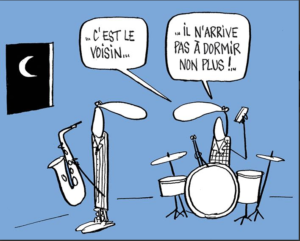Neighbourhood Disputes: The Judicial Bailiff’s Report

Poor sound insulation between aging apartments, increasingly dense neighbourhoods, rising anxiety, and more strained human relationships — these all reduce people’s tolerance. Neighbourhood disputes are common in Geneva and can quickly become serious. And it’s not always easy to know how to deal with them.
Who hasn’t suffered from excessive noise, unpleasant odours, or bulky items left in the stairwell of an apartment building? These nuisances can have a considerable impact on people’s quality of life, especially when there seems to be no solution. What can you do when faced with a disruptive neighbour?
Dialogue
First of all, of course, try to talk: conversation can help clear up misunderstandings and reach amicable agreements. It is always preferable to handle a situation by communicating respectfully, and acting to prevent harm. Learning to “live together” and being aware of each other are keys to good neighbourly relations.
There are also professional third-party services and mediation specialists that can help you untangle complex disputes. Contact us if you would like to engage in neutral neighbourhood mediation.
But if dialogue is no longer possible, there are other solutions:
Writing to the owner or property management
It is often difficult for landlords or real estate professionals to respond effectively to disputes between neighbours. Who is right? Is the nuisance really excessive? Situations are rarely black or white. Also, property managers are daily overwhelmed with tenants’ complaints. Their room for manoeuvre is limited, and reminder letters about rules often prove ineffective.
However, early termination of a lease contract is possible. This is provided for under the “Rental Rules and Uses of the Canton of Geneva” when “the behaviour of the tenant or someone living with him/her gives rise to well-founded complaints.” But what constitutes excessive or unacceptable behaviour? It depends on the tenant’s activity and whether it exceeds generally accepted norms.
Examples: making noise between 10 pm and 7 am, playing loud music, causing severe damage to common areas, posing danger to other residents, etc.
Unfortunately, such actions always leave room for interpretation and can often come down to perception and sensitivity. To increase your chances of proving the harm you’ve suffered, therefore, a file with evidence should be compiled. That way you can act more effectively against the disruptive neighbour.
Here are some elements to gather to support a complaint:
-
A police report: The police, upon request, can record nuisances, issue a warning in a mild case, or issue a fine if there is an infraction.
-
A judicial bailiff’s report: see explanation below.
-
A neighbourhood petition: Ask if your neighbours suffer from the same problems as you and collect signatures documenting these nuisances.
-
Various testimonials, photographs: Feel free to collect as much useful information as possible to support your case.
The Judicial Bailiff’s Report
You can also call on a judicial bailiff to establish a written report of the nuisances you’ve suffered or of the state of affairs. The bailiff goes on-site, at any hour and repeatedly if necessary. He can use sound measuring devices and take photographs. The public officer then drafts a procès-verbal (official report) that describes precisely the facts as they were observed.
This is useful to avoid doubts and misinterpretations, especially when a petition signed by many neighbours is not feasible.
The judicial bailiff’s report, which is often under-used and little known, is appreciated by tenants, owners, and the various real estate actors. It can also serve as evidence in legal proceedings. Indeed, judicial bailiffs are state officials appointed and sworn in by the State Council in the Canton of Geneva. Their neutrality and official status give their findings greater weight.
Advantages vs Disadvantages
Advantages:
-
Adds substantial weight to your case.
-
Precise and formal statement.
-
Practical: the bailiff can visit multiple times, in different places, even at night.
-
Use of measuring equipment.
-
Can make a difference in legal proceedings.
-
The report can also be shown to uncooperative neighbours as a deterrent.
Disadvantages:
-
Cannot document absence of noise or nuisance when the bailiff is present (if the nuisance is intermittent or not occurring at that moment).
Examples of Nuisances That May Be Reported
-
Excessive noise caused by a neighbour or construction site.
-
Bulky items or equipment stored in a common or private area.
-
Poor parking of a car.
-
Unpleasant odours, bad insulation, or outdoor installations.
-
The maintenance condition of a tree or garden.
Feel free to contact us if you would like more information about this service — we will be happy to assist you and work with you.
